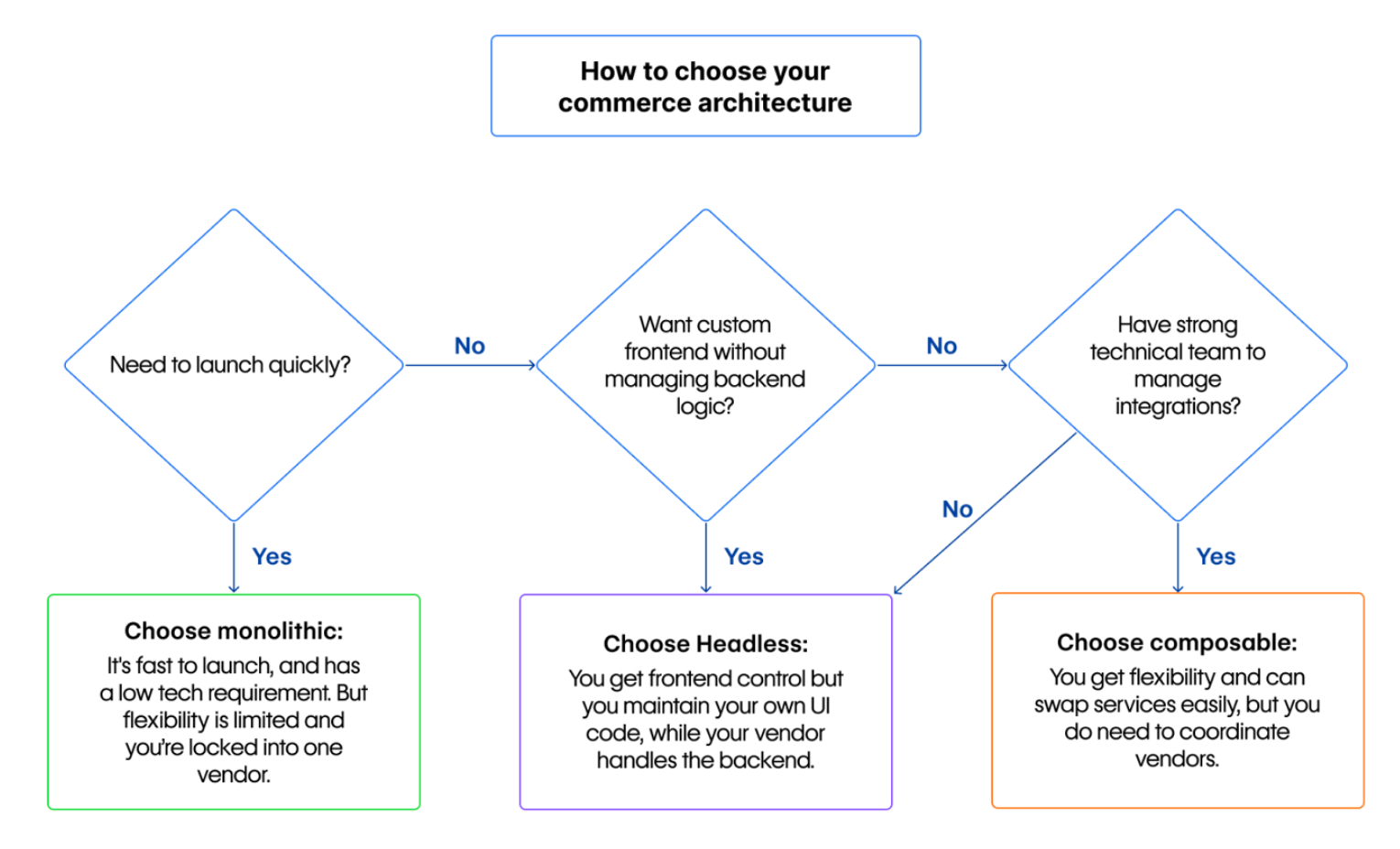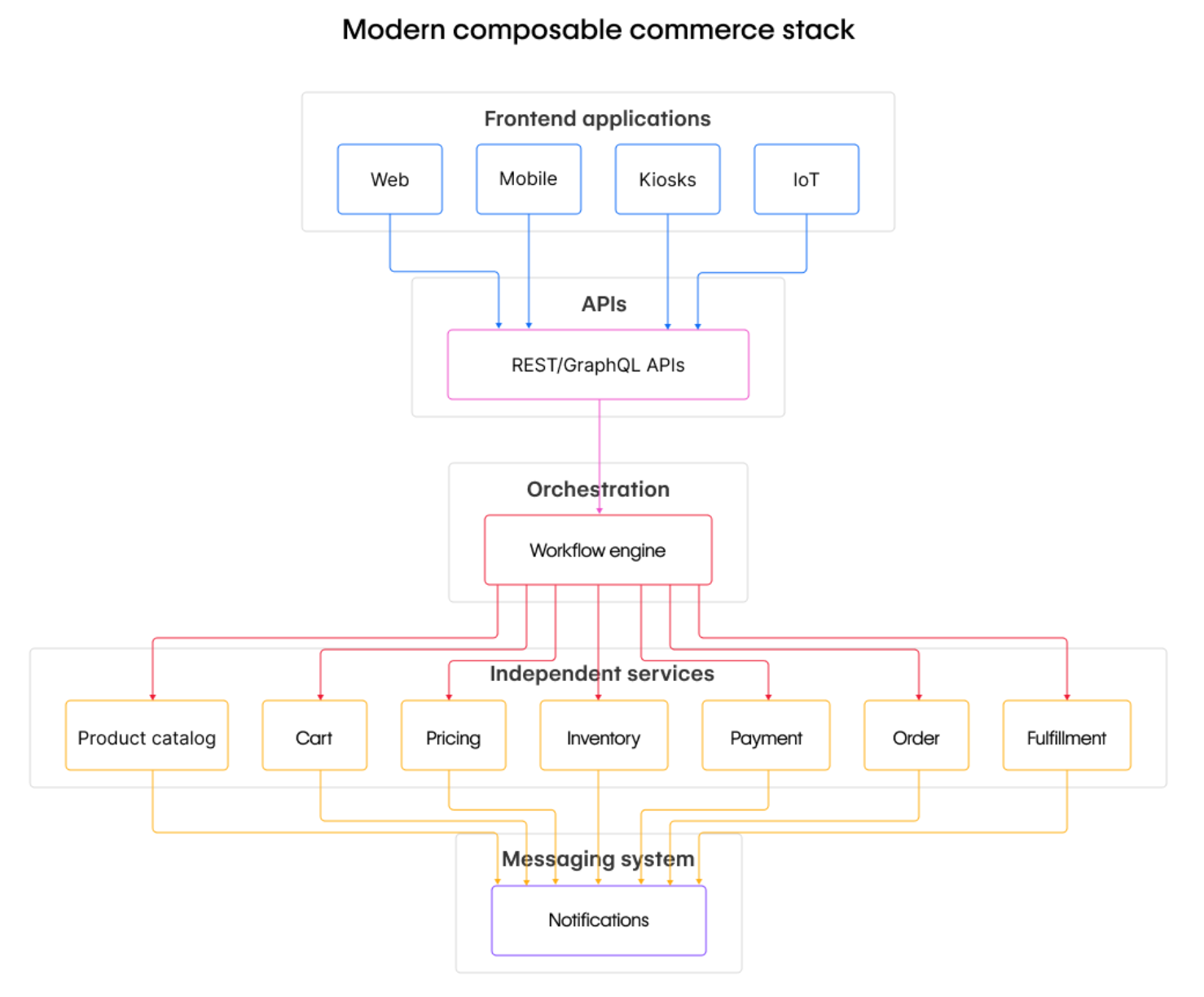Composable commerce replaces monolithic e-commerce platforms with specialized services connected through APIs, letting you update payments, search, or checkout independently without rebuilding your entire system.
Most e-commerce platforms were designed for a simpler era, when businesses just needed to sell products online. As these platforms evolved to adapt to today’s e-commerce needs, they bundled everything together — catalog, payments, checkout, and customer management.
This creates limitations as businesses scale and customer needs evolve.
Tell me if you've been here: the growth team identifies a checkout optimization, but implementation depends entirely on your vendor's development priorities and release schedule. Meanwhile, competitors using a more flexible stack deploy these features in weeks, not months.
Composable commerce replaces the monolithic approach with a modular architecture.
Rather than accepting a one-size-fits-all solution that's either too big, small, or rigid, composable commerce lets you choose the best providers for catalog management, search, payment processing, and checkout, then connect them through standardized APIs.
This modular approach follows MACH principles:
- Microservices: Independent, focused services that can be developed, deployed, and scaled separately
- API-first: All functionality exposed through standardized APIs, enabling seamless integration
- Cloud-native: Built specifically for cloud environments, leveraging their scalability
- Headless: Separation of frontend presentation from backend commerce logic
That way, teams can ship features weekly instead of quarterly, test new channels with minimal risk, and avoid the technical debt that accumulates in tightly-coupled systems.
What is composable commerce?
Composable commerce is a modular approach to e-commerce web development that uses separate, specialized services for each part of your e-commerce site.
It lets you pick individual services that excel at one thing — e.g., payments, product catalog, checkout, etc. — and connect those services through APIs.
Each service exposes well-documented REST or GraphQL endpoints that enable integration without requiring changes to other services when you modify one. And each component maintains its own data models, business logic, and operational requirements.
With composable commerce, teams can replace and improve individual services, add new capabilities, or modify existing functionality without system-wide deployments.
You can ship features faster because you only deploy individual services, not your entire platform. Instead of waiting for quarterly releases that affect everything, you push updates to specific services as soon as they're ready.
Monolithic vs. headless vs. composable commerce
There are three main architectures for building e-commerce platforms: monolithic, headless, and composable. The key difference between the three is how tightly you need your frontend and backend systems to connect.
The architecture you choose will also define how much flexibility you have when requirements change.
Here are the differences among the three architectures at a glance:
What are monolithic commerce platforms?
Monolithic platforms bundle storefront, business logic, and back-office operations into a single codebase. One vendor handles everything from catalog to checkout, which accelerates initial deployment with limited resources.
The downside is everything's connected. Simply adding a payment provider or updating search functionality may require full application redeployment and vendor release coordination.
Technical debt accumulates as customizations conflict with platform updates, creating slow innovation cycles and expensive upgrade paths.
What are headless commerce platforms?
Headless commerce decouples frontend from backend through APIs.
Headless gives you frontend flexibility while the backend architecture varies by platform. You can build custom storefronts, mobile apps, or other interfaces while the backend handles products, orders, and payments.
Some headless platforms, such as Shopify Plus, have backends that are less modular than fully composable architectures, though they still offer API-based services for extending functionality.
The tradeoff is more development work. You need to build and maintain your own frontend, handle API integration, and manage the connection between your custom interface and the commerce backend.
What are composable commerce platforms?
Composable commerce implements full decoupling. Every business capability runs as an independent service known as a microservice or Packaged Business Capability (PBC).
Each service communicates through open APIs, so you can swap out your payment processor, search engine, or product catalog without affecting the other services.
The downside is complexity. You're managing multiple vendors, API integrations, and service dependencies. This requires more technical expertise and ongoing operational overhead compared to a single platform.
The pros and cons of monolithic, headless, and composable platforms
Each approach has clear advantages and disadvantages depending on your situation.
Monolithic platforms get you up and running fastest. Everything works together out of the box, so you don't need to integrate different services or manage multiple vendors. But changing anything later often means waiting for your platform vendor's release schedule.
Headless gives you frontend control while keeping commerce backend complexity managed. You can build the exact customer experience you want while someone else handles inventory, orders, and payments. The tradeoff is you're building and maintaining your own frontend code, which can be difficult and time-consuming. Especially if someone else on your team needs to make changes down the line.
Composable lets you pick the best service for each function and swap them independently. Your search engine can be Algolia, payments through Stripe, and product catalog from a different vendor entirely. But you're also managing multiple vendors, API integrations, and potential service outages across different systems.
Choose your architecture based on your team's skills and time constraints. Here’s a quick guide to help you choose:

If you need to launch quickly with limited technical staff, monolithic platforms work well. If you want custom experiences but don't want to build commerce logic, headless fits. If you have the technical resources to manage complexity, composable gives you the most options.
Why businesses adopt composable commerce
Businesses adopt composable commerce to ship features faster and avoid getting stuck with one vendor's roadmap. With monolithic platforms, every change requires updating the entire system, which slows down releases and can create conflicts between different teams' work.
Composable commerce fixes this by letting you update services independently. Here's why teams make the switch:
- Teams can work in parallel. Your frontend developers can update the website while backend developers work on inventory management. Neither team blocks the other.
- You can scale services based on actual usage. If search gets heavy traffic during a sale, you can scale just the search service without paying for extra payment processing capacity you don't need.
- Each service has its own deployment process. You can update your recommendation engine without touching checkout. You can roll back payment changes without affecting product catalog. You can test new features on a subset of users.
- You're not locked into one vendor. Services connect through standard APIs, so switching from one payment processor to another doesn't require rebuilding your entire system. When vendors change pricing or discontinue features, you can replace just that service.
- You can add new features without breaking existing ones. Want to add subscription billing? You can build it alongside your current payment system. Rolling out international checkout? You can deploy it in specific regions first.
Teams using composable commerce can run A/B tests across different services, deploy features gradually, and handle complex scenarios like serving different customer segments. This reduces the need to completely rebuild your platform every few years as your business grows.
The tradeoff is complexity.
You're managing multiple vendors, integrating dozens of APIs, and handling different release schedules across services. This requires more technical expertise and upfront costs before you see benefits.
Small teams with straightforward requirements often get more value from monolithic or headless platforms. Start with one high-impact service like search or checkout to test your team's readiness before migrating everything.
How composable commerce architectures work
A modern commerce stack consists of loosely-coupled layers that each handle a single concern, enabling independent replacement or scaling without system-wide impact.
Microservices form the foundation, organized into self-contained PBCs like product catalog, cart, pricing, and promotions. Each PBC is self-contained, meaning each operates as an independent service with its own database, business logic, and deployment pipeline.
Since each service runs independently, you can update your pricing engine without taking down checkout or breaking product searches.
APIs connect everything. Each PBC exposes REST or GraphQL endpoints, and a messaging system handles notifications like order.created, inventory.reserved, payment.failed between services.
For example, if you're using Avalara for tax calculations and want to switch to TaxJar, you update your checkout service to call TaxJar's API instead. Your checkout logic stays the same — it still sends product data and gets tax amounts back.
Your orchestration middleware coordinates the services. When a customer clicks "buy," you need to check inventory, charge their card, screen for fraud, and book fulfillment in the right order. If the payment fails, you need to release the reserved inventory.
A workflow engine, known as your orchestration layer, handles this coordination so your individual services don't need to know about each other.
Your website, mobile app, and any other frontend all use the same APIs. Whether someone's shopping on your website or mobile app, they're pulling the same product data and using the same checkout process through API calls.
You design UI components once and deploy across channels, or create channel-specific experiences without modifying backend logic.
Here’s what a modern composable commerce stack can look like:

The interaction becomes clear during a purchase flow:
- A "Buy" click triggers an API call to the order service
- The inventory service reserves the items and tells other services, "these items are now held for this customer"
- The payment service charges the credit card
- The notification service sends the confirmation email
- If any step fails (like payment declined), the orchestration engine cancels the whole order and releases the reserved inventory
You can update any of these services without breaking the others or taking your site offline.
How to implement composable commerce
Start with one service and build from there. A successful composable implementation means planning each step carefully.

First, map your current system. Write down every API your site uses, how data flows between them, and what handles authentication. Document which systems talk to each other. Most teams discover way more connections than expected.
Then, pick one service to replace first. Choose a high-traffic service like product search or checkout. Keep everything else running on your current platform. This lets you test composable architecture without risking your whole business.
After that, test vendor APIs thoroughly before committing. Read their documentation, test their webhooks with real data, see how they handle errors, and try their authentication flow. Poor API design will multiply problems as you add more services.
Next, build authentication and monitoring infrastructure. Set up a system to handle logins across all services and route requests properly. Add monitoring to track when services go down or slow down. Without this foundation, your services become isolated islands.
Finally, set up independent deployments from day one. Each service needs its own deployment pipeline and tests. Use feature flags to gradually roll out changes to small groups first, then expand.
Repeat the process with the next service. Once your first service runs smoothly for a few months, migrate the next one. This approach builds your team's expertise while keeping your site stable.
After you set up your services, monitor performance and costs. Track API response times, error rates, and traffic volumes for each service. Review these metrics monthly to identify bottlenecks and optimize spending.
Choosing the right composable commerce platform
Your development team will build using the infrastructure you choose for years. Focus on technical depth, API reliability, and how well it fits your existing systems.
Check the technical requirements first. Look for microservices architecture, API-first design, cloud hosting, and headless capabilities. Test the APIs thoroughly - try their REST endpoints, check rate limits, use their sandbox, and see if the documentation is actually helpful.
Make sure you can extend it. You need ways to add custom code, reliable webhooks, and support for serverless functions without modifying their core platform. Good platforms give you SDKs and event streams to build new features instead of forcing workarounds.
Verify the infrastructure claims. Don't trust marketing about performance and uptime. Ask for actual numbers on scaling, regional availability, and what happens when things break. Check that their security and compliance features match what your company requires.
Calculate the real costs. Beyond the base price, factor in API usage fees, integration work, and scaling costs as you grow. Look at their partner ecosystem - active communities and integrations reduce long-term headaches.
Platforms fall into four main types:
- API-first commerce engines - handle cart, catalog, and checkout
- Headless CMS platforms - content management with commerce features
- Integration platforms - connect different services together
- Frontend platforms - focus on building user interfaces quickly
Choose based on your team size and skills. Small teams benefit from platforms with good defaults and integrated workflows. Large teams with DevOps expertise can mix and match specialized services from different vendors.
Think beyond your current needs. Check vendor roadmaps, how easy it is to leave if needed, and whether their approach will work as your business grows. The whole point of composable commerce is flexibility - don't pick a platform that locks you in.
Where Webflow fits in a composable strategy
Webflow can serve as the frontend, CMS, and hosting layer in composable commerce setups, handling design, content, and delivery while connecting to backend services through APIs.
Most composable implementations face the same challenge: how do you let marketers and designers update customer experiences quickly without constantly involving developers?
Webflow solves this by giving non-technical team members visual control over the customer experience. Marketers can update product pages, create landing pages for campaigns, or restructure site navigation without touching code.
Meanwhile, developers focus on integrating the APIs that power search, checkout, and inventory management.
The platform connects to your existing commerce infrastructure through standard web APIs. Your specialized backend services handle the complex business logic while Webflow manages what customers see and interact with.
This approach works particularly well for teams transitioning to composable commerce.
Start by rebuilding your customer-facing site in Webflow while keeping your current e-commerce platform running behind the scenes. Once your new frontend proves successful, you can gradually replace backend services with specialized solutions. This reduces migration risk while building the foundation for a fully modular system.
































